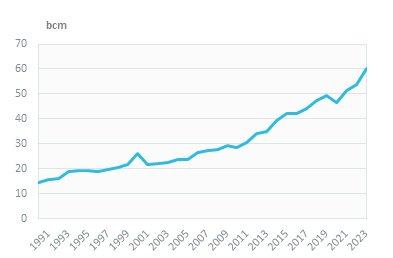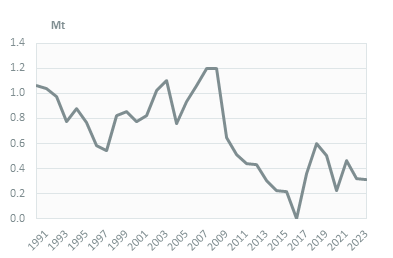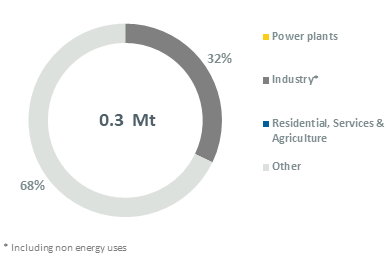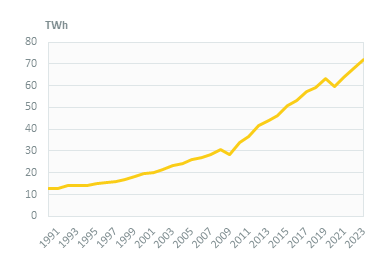-
-
 Energy and Climate Databases
Energy and Climate Databases- The most comprehensive and up-to-date annual energy database.
- Monitoring of technology providers in H2 supply chain.
- Monthly energy data on key energy markets.
- Monitoring of Hydrogen and Derivatives Projects
- The most reliable and up-to-date power generation database.
- The essentials of LNG trade at your fingertips.
- Global monitoring of new and existing refineries.
- Analyse energy consumption and efficiency trends at world level. Benchmark countries.
- Have your database developed by a recognised expert of both energy and IT.
-
 Energy - Climate Forecasts
Energy - Climate Forecasts- Future carbon costs with reliable price forecasts
- Instant access to energy and emissions forecasts.
- Annual projections of wholesale prices up to 2050, based on a 360° approach of the energy markets, enabled by the globally recognised POLES model.
- Wedges module showing a breakdown of the levers enabling to reduce emissions between two scenarios.
- Unique, independent projections of consumption by end-use.
- GHG Marginal Abatement Cost Curves.
- Benefit from proven models to draw your own energy scenarios and anticipate tomorrow’s challenges.
-
 Market Intelligence
Market Intelligence- 110 Energy and climate country reports.
- Tracking trends, EPCs, and national subsidy schemes for residential buildings.
- Daily brief covering the entirety of the turbine industry.
- A newsletter to receive the latest updates on evolving technologies and policies.
- Global energy news and analyses curated daily.
- Enerdata’s experts bring you the essentials about your market and competitors.
-
-
-
 Market Analysis
Market Analysis- Understanding key consumption trends and drivers across sectors.
- Granular and exclusive insight to address the most pressing business and strategic issues.
- Expertise in strategic and business intelligence, with fine-tuning to the market’s specificities.
-
 Energy - Climate Scenarios
Energy - Climate Scenarios- Providing the outlook of an energy commodity in mid to long term time horizons.
- Sector and driver specific energy demand forecasting.
- Assess the evolution of energy prices on the international and regional markets, as well as end-users prices.
- Enerdata guides you through pathways to reach climate targets.
- Supporting local authorities in their decarbonisation strategies.
-
 Climate Strategy and Policy Evaluation
Climate Strategy and Policy Evaluation- Cutting-edge quantitative tools and relevant indicators to monitor and evaluate evolutions on worldwide energy markets.
- Analysis of the most cost-effective options to reduce emissions.
- Quantified simulation and analysis of pledges for climate change negotiations.
- Breakdown of carbon markets and evaluation of the climate change impacts on the carbon price.
- Enerdata guides you on the most beneficial policy or investment options.
- Turning climate objectives into concrete action plans.
-
 Training
Training- Understand different policy targets and measures on energy efficiency.
- How to measure energy savings?
- Energy Forecasting is a 2 days training to learn to design and interpret energy forecasts.
- Energy statistics training allowing to create energy balance with supply, transformation and consumption and understanding the international energy statistics regulations.
- Initiation to EnerMED level 1is the training to approach on the most powerful energy demand forecasting model.
-
-
Resource Centre
Algeria Key Figures
- Population:
- 45.6 million
- GDP growth rate:
- 4.10 %/year
- Energy independence:
- 100%
Data of the last year available: 2023
- Total consumption/GDP:*
- 147 (2005=100)
- CO2 Emissions:
- 3.35 tCO2/capita
- Rate of T&D power losses:
- 11.4%
* at purchasing power parity
View all macro and energy indicators in the Algeria energy report
Algeria Energy News
View all news, archive your new and create your own daily newsletters only on your topics/countries of interest with Key Energy Intelligence
Algeria Energy Research
Benefit from up to 2 000 up-to-date data series for 186 countries in Global Energy & CO2 data
A data overview is available in the global energy statistics app
Algeria Total Energy Production & Consumption
Compared to other developing countries with a similar development level, Algeria's consumption is high (1.5 toe per capita), partly because of consumption and losses in the energy sector (oil & gas production and LNG plants, mainly). Electricity consumption per capita reaches 1 584 kWh (2023).
Total energy consumption has increased rapidly since 2020 (7%/year), reaching 70 Mtoe in 2023. It grew steadily by 5%/year on average over 2010-2019.
Graph: CONSUMPTION TRENDS BY ENERGY SOURCE (Mtoe)
Source: Algeria energy report
Interactive Chart Algeria Total Energy Production & Consumption
Source: Global Energy & CO2 data
Benefit from up to 2 000 up-to-date data series for 186 countries in Global Energy & CO2 data
View the detailed fondamentals of the market at country level (graphs, tables, analysis) in the Algeria energy report
Algeria Oil Production & Consumption
Oil production (crude oil and NGL) decreased by 3% in 2023 to 60.9 Mt, after a 7% progression in 2022. In 2021, there was slight growth of 1%, after a significant decrease of 11% in 2020. Oil production was stable over 2012-2019 at around 67 Mt, following a period of decline since 2007 from 88 Mt.
Around 1/3 of the crude oil production is exported (22 Mt in 2023); that figure has been decreasing over time (-2%/year on average since 2012).
Source: Algeria energy report
Interactive Chart Algeria Crude Oil Production & Consumption
Source: Global Energy & CO2 data
Interactive Chart Algeria Refined Oil Products Production & Consumption
Source: Global Energy & CO2 data
Benefit from up to 2 000 up-to-date data series for 186 countries in Global Energy & CO2 data
Additionally, for more detailed information on refineries, you can request a sample of our EMEA Refineries Dataset
Algeria Natural Gas Production & Consumption
Gas consumption increased by 12%/year between 2020 and 2023 to 60 bcm, after a progression of 5% in 2022. Previously, it had been increasing by more than 6%/year over 2010-2019.
Power plants consume 42% of the gas, followed by buildings (residential and services, 24%) and industry (19%) (2023). The remaining 14% is used by the hydrocarbon sector.
Graph: NATURAL GAS CONSUMPTION (bcm)

Graph: GAS CONSUMPTION BREAKDOWN BY SECTOR (2023, %)
Source: Algeria energy report
Interactive Chart Algeria Gas Production & Consumption
Source: Global Energy & CO2 data
Benefit from up to 2 000 up-to-date data series for 186 countries in Global Energy & CO2 data
Additionally, for more detailed information on the LNG trade, you can request a sample of our EMEA LNG Trade Dataset
Algeria Coal and Lignite Production & Consumption
Coal consumption is low (0.32 Mt in 2023).
Graph: COAL CONSUMPTION (Mt)

Graph: COAL CONSUMPTION BREAKDOWN BY SECTOR (2023, %)

Source: Algeria energy report
Interactive Chart Algeria Coal and Lignite Production & Consumption
Source: Global Energy & CO2 data
Benefit from up to 2 000 up-to-date data series for 186 countries in Global Energy & CO2 data
View the detailed consumption trends at country level (graphs, tables, analysis) in the Algeria energy report
Algeria Power Production & Consumption
Electricity consumption has been increasing very rapidly since 2010 (1.69%/year), reaching 72 TWh in 2023. The electrification rate is close to 100%.
Graph: ELECTRICITY CONSUMPTION (TWh)

The residential sector accounts for 38% of electricity consumption, followed by industry with 33% and services with 20% (2023).
Graph: ELECTRICITY CONSUMPTION BREAKDOWN BY SECTOR (2023, %)
Source: Algeria energy report
Interactive Chart Algeria Power Production & Consumption
Source: Global Energy & CO2 data
Benefit from up to 2 000 up-to-date data series for 186 countries in Global Energy & CO2 data
View the detailed consumption trends at country level (graphs, tables, analysis) in the Algeria energy report
Algeria Renewable in % Electricity Production
The Renewable Energies and Energy Efficiency Commission (CEREFE), created in 2019, contributes to the national development of renewables and energy efficiency as an adviser and evaluates the national policy.
The Programme for the Development of Renewable Energy (2022) targets 22 GW of renewables by 2030, divided between 62% of solar PV and 23% of wind. This target means that 37% of the total installed capacity and 27% of the power mix will be from renewable sources. As only 0.6 GW have been installed at the end of 2023, this objective seems difficult to reach.
Source: Algeria energy report
Interactive Chart Algeria Share of Renewables in Electricity Production (incl hydro)
Source: Global Energy & CO2 data
Benefit from up to 2 000 up-to-date data series for 186 countries in Global Energy & CO2 data
Algeria GHG emissions and CO2 emissions
In its NDC, the country announced its aim to reduce GHG emissions by 7% by 2030 compared to a BAU scenario, which could be raised to 22% under the condition of access to new financial resources from bilateral and multilateral partners, as well as clean technology transfer on concessional and preferential terms.
CO2 emissions from energy use are growing rapidly, by around 4%/year since 2010, reaching 153 Mt in 2023. Algeria is the third largest emitter of CO2 in Africa.
Graph: CO2-ENERGY EMISSIONS (MtCO2)
Source: Algeria energy report
Interactive Chart Algeria CO2 emissions
Source: Global Energy & CO2 data
Benefit from up to 2 000 up-to-date data series for 186 countries in Global Energy & CO2 data
View the detailed consumption trends at country level (graphs, tables, analysis) in the Algeria energy report